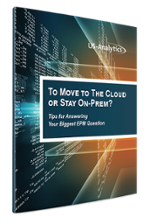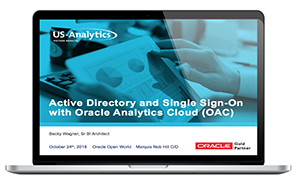If you didn’t make it to OpenWorld this year, we’ve got you covered with the key takeaways from the EPM and BI sessions.
In this blog post, we’ll first look at the EPM highlights, including…
- An updated roadmap for on-prem EPM Hyperion solutions
- Moving from Hyperion to the Oracle EPM Cloud
Then we’ll talk about BI highlights, including…
- Getting started with OAC
- OAC Essbase Capabilities and Roadmap
- Active Directory & Single Sign-On with OAC
EPM Insights
What does the future of EPM hold? Based on these two sessions, that really depends on your organization. There are a couple of paths you can take that are detailed in the presentation summaries below.
Updates to the On-Prem EPM Roadmap
Oracle has been diligently updating Hyperion users at every conference about the future of their on-prem EPM tools. At Kscope17, Oracle announced that premier support would end for its entire suite of on-prem Hyperion solutions. As of OpenWorld, that date still stands.
Part of the on-prem strategy for the upcoming (and the reportedly last) version of Hyperion is that the enhancements will be driven completely by customer needs. This hasn’t changed — neither has the release date of early 2019 (still no firm date).
This new version, 11.2, will also include a repository simplification, replacing Foundation Services with a more streamlined RDBMS repository.
Notable Hyperion Planning features include…
- Smart Push
- Dimension Editor SV extension
- Extended Attribute Support
- Valid Intersections
Data Relationship Management (DRM) will also get a facelift, with features including…
- Scheduled Imports, Exports, and Books
- DRG Mass Approvals
The 11.2 Hyperion Financial Management (HFM) features you can look forward to include…
- Automated consolidations
- Web-based Metadata Editor
- Archiving/deleting unwanted data
- Performance improvements
- SV, DB batch processing, etc.
For more 11.2 features and benefits, download the presentation.
Moving from Hyperion to the EPM Cloud
Of course, with premier support ending in 2030, Oracle is focused on a cloud-based strategy. Moving Hyperion to the Cloud is a common presentation topic at conferences. This presentation focused on going more in-depth with the benefits of moving to the EPM Cloud.
One of the most common things you hear about the cloud is the savings on hardware implementation and maintenance. You won’t have to upgrade your system, either — it’s all automatic. However, when something does go wrong with the hardware, you’re putting all your trust in Oracle to fix the issue. Less responsibility plus lower cost equals less control.
One of the greater perks of the cloud is how you can truly bring your national and global processes together. Everyone can work in the same tool. As Oracle puts it, you’ll “facilitate a more agile organization.” Not only is it connecting your finance office, no matter where they are — you can also better align financial and operational process with a “connected architecture.”
There was also a keynote address by Oracle CEO Mark Hurd at OpenWorld in which he called the cloud “irrefutable” and “foundational.” He, of course, mentioned one of the buzziest buzzwords — artificial intelligence — and some predictions that by 2025…
- 100 percent of cloud apps will include AI
- 85 percent of customer interactions will be automated
- 60 percent of future IT jobs have not been invented yet
At OpenWorld, we learned that it’s all about the cloud when it comes to EPM. Except that’s not quite true with Hyperion 11.2 on the horizon. What will you choose? The move to the cloud or to stick with on-prem for a while?
If your organization is grappling with the question, download the eBook…
BI Insights
You can’t talk about Oracle BI right now without mentioning the Oracle Analytics Cloud (OAC) platform. It’s for good reason. If this platform were a shampoo, it’d wash, condition, rinse, dry, and style your hair with the squeeze of the bottle. It can do a lot.
There’s a lot of information about on-prem Oracle BI solutions out there (such as in our blog), so we decided to exclusively highlight the OAC presentations.
Getting Started with OAC
Why should your organization even bother with OAC? It’s not just all the functionality and services that are included. The fact is all that functionality is a little daunting, but you don’t have to implement it all at once.
OAC allows you to expand and scale analytics based on your business needs. You also have the flexibility to integrate with various solutions, such as…
- ERP Financials Cloud
- PBCS or EPBCS
- EBS
If you are interested in learning more about getting started with OAC, let’s chat. We have several consultants who’ve just completed OAC projects and know a thing or two about making a project successful.
OAC Essbase Capabilities and Roadmap
Many Hyperion Planning customers also have Essbase, so it might feel a little odd to implement OAC so that you can get Essbase in the Cloud.
Fortunately, Oracle gave us 20 reasons to consider Essbase in the cloud in this presentation. Here are 5 of those reasons:
- PaaS (Platform as a Service) Benefits
- There’s elasticity — you can use as much capacity as you need
- Backup and restore
- Create/Start/Stop and monitoring of the service
- DV to Essbase
- Since DV and Essbase are on the same platform, the integration is seamless
- You can create an Essbase Cube as a target of DV Data Flow
- Load data into an Essbase Cube and quickly analyze
- Automatic Performance Analysis
- There’s data collection and a performance advisor every “X” hour
- You’ll get database metrics like number of cubes, dimension, cells, and more
- You be able to see auditing metrics, abnormal metrics, user metrics, system metrics, and operational metrics
- Scenario Management and Sandbox
- Create cubes and enable scenarios
- You can also add participants and approvers, as well as see the work flow steps
- Drill through
- Users can select a range of cells (rather than one) to drill through
- The range doesn’t have to be contiguous
For more reasons to consider Essbase in the Cloud, download the OpenWorld presentation.
Active Directory & Single Sign-On with OAC
One of our Oracle ACE Associates presented a session on setting up active directory and single sign-on based on her experience setting it up for a large financial management company.
This presentation will help administrators understand how to set up OAC and avoid hiccups. In her presentation, she covers several tutorials for…
- AD Bridge
- SAML 2.0 ADFS
- Direct SSO vs. Link
- Trouble Spots
You can download the presentation and see those tutorials here.
Conclusion
The cloud is very much here, and Oracle is going to be putting all the innovation into its cloud products. But, you have time to get ready for that move. You can even wait until after 2030, when premier support for Hyperion expires.
Essbase is in the cloud now as part of OAC, which integrates with PBCS. The Oracle Cloud attempts to bring more of your solutions together to make your organization more agile. The key message from this OpenWorld is that your organization has more power than ever to discover insights and improve business processes.







